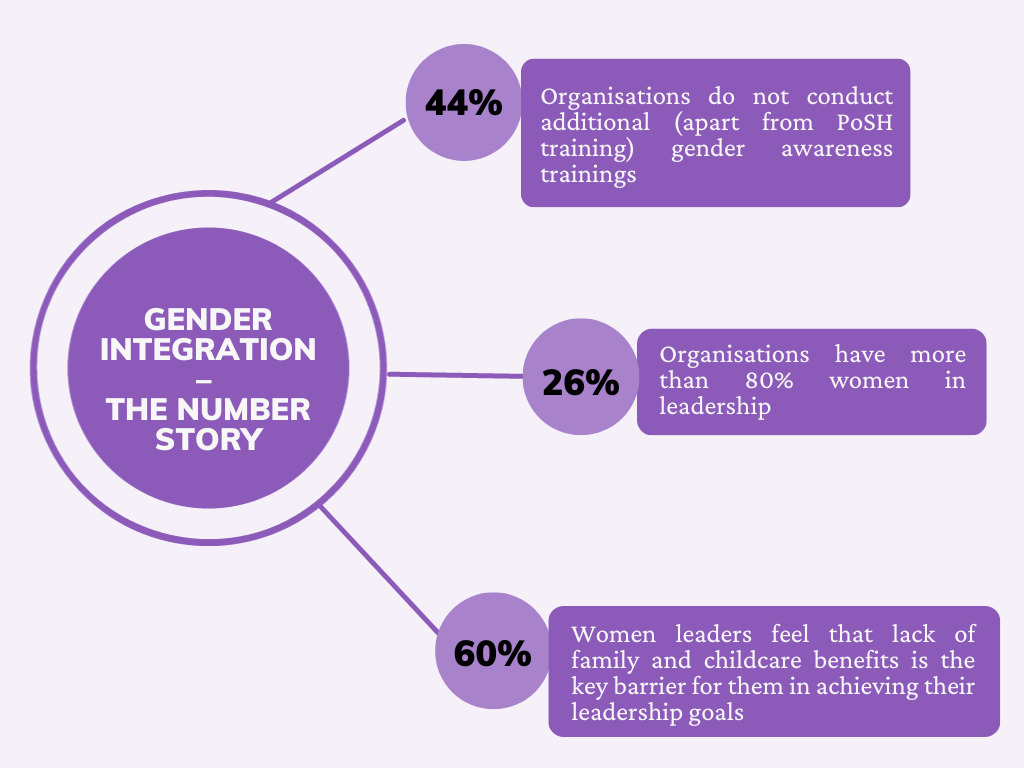Changing how Workplaces Work: Embracing the power of Gender Integration at Workplace
By Nidhi Tewari
Imagine a workplace where everyone is treated with respect and gets their due recognition – a place where gender doesn’t hold anyone back. While we all wish this was the case, the reality is quite different. Making workplaces truly gender-inclusive, is still a work in progress. To make sure workplaces are fair for all genders, it’s important to be intentional about gender-integration.
Gender integration (or mainstreaming) at the workplace is the process of including gender perspectives in the organisation culture- in all areas and at all levels to help organisations achieve gender equality. This means bringing equality into the heart of how organisations roll. Recognizing the importance of gender integration at work, Arthan’s Women at Work initiative undertook a landscaping study consisting of 70 organizations in India’s development sector to understand the realities and challenges of gender integration at workplaces. These organisations were chosen through a purposive sampling technique by leveraging Arthan’s networks in the development spaces. Mid-senior level women employees, women leadership, and DEI experts were interviewed for the purpose of the study. Our research showed something important: making workplaces equal isn’t just about hiring more women. It’s about building a culture that welcomes different viewpoints and lets everyone have a say in decisions. Think of it like putting together a great song – you need all the different parts to come together in harmony.
Let us begin by looking at the need for gender integration. Why is there a need for gender integration and who does it concern? Our research shows that in the development space, although the cognizance of gender inequality is high, there still exists a major gap in the interventions to address it. Let’s look at some numbers here that give us a snapshot of the situation:
Need for Gender Integration – The Number Story

But, “Why should we care about Gender Integration?” you might wonder. Well, the answers we discovered in our research are pretty convincing:
- Creativity and Productivity: Studies have shown that diverse firm’s productivity is 1.32 times higher than firms who do not have diversity. Imagine a mix of different ideas coming together – that’s where the magic of innovation happens. When people of all backgrounds work together without biases, their diverse perspectives can create incredible new things.
- Boosting Morale: What would you pick if you had to choose between a workplace where everyone helps each other, where as a woman you feel a sense of equality and security, or a workplace that whitewashes their identities? The answer is simple, isn’t it? Studies show that inclusive and sustainable policies for women increase morale, thus fostering more work satisfaction and lesser attrition. On being asked a similar question, one of the research participants from our study said:
“As women, who shoulder care responsibilities and children and what not, an inclusive workplace where you feel respected is the only factor good enough to motivate you to wake up in the morning and come to work every day.” – a mid career women development professional
- Shattering Stereotypes: Gender stereotyping of roles often leads to women getting only certain types of jobs that are considered more “women like” when such stereotypes are challenged, it creates an environment for employees to tap their hidden potential and exceed set expectations. About stereotyping at the workplace, one of the research respondents said:
“There are different recipes for leadership. It is about an acceptance of traits. If you are open to just the traits and not the people, gender diversity comes easy.”- a senior women leader
Overcoming Challenges
When we talk about “Gender integration in the organization’s culture,” it’s important to understand that it’s a sensitive issue. Creating a gender-inclusive environment that acknowledges intersectionalities and respects diverse lived experiences demands continuous commitment. This can potentially be influenced by factors such as the level of diversity within decision-making panels or the need for guidance in effectively integrating gender into workplace processes. Through our research we were able to capture some challenges that organisations have faced in their efforts of creating gender inclusive spaces:
Tangled Traditions: Sometimes, societal beliefs and traditions related to women and their roles can affect the efforts of gender integration at the workplace. That is because the cultural norms often get transcended into the work culture. Patriarchal mindsets in men, internalised marginalisation and misogyny in women are ways in which societal ethos can creep into workplace ethos.
Source: Adapted from MOSPI
- Balancing Act: Creating a work-life balance for women is an integral component of gender integration. Understanding the nuances of what work-life balance for women can look like, and creating an atmosphere where women can balance responsibilities without losing out on opportunities at work has to be curated and maintained perpetually. Speaking of this balancing act and why organisations need to help women maintain work-life balance, one of our research respondents said:
“Women getting married as a liability or choosing to bear a child, is often seen as a liability. Instances of hiring conversations surrounding this topic has prevented more women from joining the workforce in the development sector and/or progressing further in their careers.” – a mid-senior level women professional
- Biases in the Shadows: We all have hidden biases we might not even know about. When it comes to making decisions, like who gets promoted, these biases can sneak in. Tackling them requires a watchful eye. Regarding bias at workplace, one of our respondents said:
“I have been rejected for the same opportunity by a male superior for which my male junior was selected. This shows the bias we have to face as women.” (Mid Career Women Professional).
The bias runs both ways and is not unilateral. Another respondent of the study explained this by saying:
“As women Leaders, we have often felt the subconscious pressure of supporting other women, but one has to acknowledge that and be mindful of such biases” (Senior Women Leader).
- Cultural Shifts Take Time: Changing the way an entire organization thinks and acts isn’t something that happens overnight. It’s like planting a garden – it needs time and effort to grow. This is especially true when teams are big or working from different places.
How can we facilitate Gender Integration?
“Gender integration in the organization’s culture” might sound like a mouthful, but it’s really about understanding that it’s a sensitive issue. There will be challenges, like old beliefs, finding balance, fighting biases, and building a new culture. But by taking it one step at a time, organizations can make things better for everyone. Now, that we have understood the challenges to gender integration at workplaces, how about looking at some solution? Through our research we were able to put together some solutions that have worked for organisations in making their workspaces gender inclusive. Along with important initiatives like a POSH training session, here are some ways in which organisations can make a difference:
Three Ingredients to boost Women Leadership: Statistics suggest that for every 100 men promoted at entry-level jobs, only 87 women are promoted and this number is even lower for women of colour, caste and other marginalised groups. The synergy of the 3 ingredients- recruitment equity, mentoring and supportive leadership settings empowers women to confidently pursue influential roles, driving diversity and equality.
Flexibility in Work: This simple change lets employees balance their jobs and personal lives much better. Often, women take on most of the caregiving responsibilities, and offering flexible work arrangements for both men and women may help correct the gender imbalance of caregiving responsibilities. The IWG survey suggests that over 67% women feel that hybrid work gives them more flexibility and in turn they feel that their productivity has risen as they are able to strike a balance between work and caregiving responsibilities.
Parental leaves and Childcare: Paid parental leave is crucial. It’s a step towards sharing caregiving responsibilities between moms and dads. In a study done at the University of Virginia, it was found that a five-year earlier access to childcare can increase female employment rate by 1.4 percentage points.
Seeing Beyond Biases: We all have these hidden biases that we might not even know about. Unconscious bias training helps us spot them and learn how to deal with them. This is important for treating everyone fairly. Studies show that having learning modules about different types of workplaces bias, supervisors taking feedback from everyone depending on their personality types, holding small group discussions and creating empathy are a few ways in which unconscious bias can be managed.
Small actions go a long way: Being mindful of pronouns, period literacy, adopting gender-sensitive language and practising gender mindfulness are small things that build a gender-inclusive organisational culture.
In Conclusion
Gender integration isn’t just about being fair; it’s like a smart plan for organisations that want to succeed in our interconnected and diverse world. When companies take on gender integration, they’re making a plan to create a workplace where everyone can shine. By embracing these practices, organisations can make their workplace a more inclusive and safe place to work. We have to unlearn and relearn that it’s not about ignoring gender differences; it’s about celebrating them and this paradigm shift could be like sunrise, making the future at work even brighter for women.


